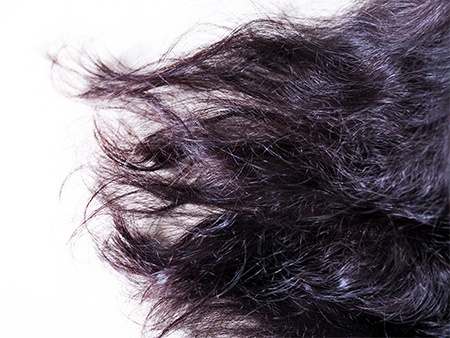We tend to pull our hair out in frustration if it starts to fall out or break. Though most individuals might have experienced hair loss at some point in their lives, acute hair loss and balding can be concerning.
If you’re wondering how to prevent hair breakage, you’ve landed at the right place.
Hair breakage
There are myriad ways that breakage manifests itself and ultimately results in hair loss, with frizzy hair or split ends is the most common signs. Shorter hair near the hairlines or thin hair at the ends is probably due to hair breakage.
Breakage primarily affects dry strands, which are frequently the result of heat styling, frequent bleaching or even stress.
When hair is healthy, the cuticle scales on each strand are aligned separately, giving smooth and shiny hair. Hair can separate from the scalp when it is dry or damaged, causing frizz, brittle texture and, finally, breaking.
Although it may appear like hair fall and hair breakage are the same thing, they are not the same. The hair cycle includes a natural phase of shedding. On average, an individual sheds between 50 and 100 hairs each day.
A person should be concerned about the sudden thinning or a continuous loss of more than 100 hairs daily.
Contrarily, breakage occurs when the actual strand itself falls. Most of the time, we just see small hair fragments on the ground rather than whole hairs.
Breakage occurs when these individual hair fibre sheets separate from the remaining pile of hair strands. The split ends can rip from the tips, halfway up the strand or even close to the root. Several diverse factors usually affect where and how hair breaks.
Causes of hair breakage
Heat-incorporated styling
The hair may get dry and damaged from excessive heat style, which will eventually cause breaking. Avoid using hot hair tools as much as possible and choose a heatless style, such as overnight beach waves or a protective style, when the hair is prone to breaking.
Dry Strands

Dry strands of hair almost always experience breaking. The hair requires moisture to remain healthy, just like the rest of the body. Since the ends of long hair are farthest from the scalp, they are more likely to exhibit indications of dryness initially. When hair becomes too dry, it might feel like a straw to the touch.
Hair that is dry and brittle is more prone to breakage and damage. Using harsh chemicals, shampooing the hair too frequently, and using hot water to wash it can make this condition worse. Dryness and breakage can also be caused by not applying a conditioner after cleansing the scalp.
Stress
Stress can cause hair loss. Stress is harmful in pretty much any situation. Hair loss caused by stress is temporary, so attempting to reduce stress levels can make the hair look better by combating hair fall.
Hairstyles
Hair styling is one of the main causes of breakage. The most common causes of hair breakage include,
- Hard brushing and combing.
- Sleeping on wet hair or materials that cause friction.
- Tugging the strands into tight shapes frequently.
- Heat styling.
When there is tension on the hair shaft, it can lead to inflammation at the root. As a result, the strands get weaker and may eventually fall out.
How to stop Hair breakage?
Maintain hair hydration
One may not moisturise the hair sufficiently, which could be one of the leading reasons for hair loss. For people with curly hair, which is prone to becoming brittle and falling off, paying extra attention to moisturisation is necessary. Pampering the hair is never difficult.
Treat split ends
After detangling the hair, use a nourishing leave-in conditioner to smooth and seal split ends and to refresh the curls in between washes.
Before shampooing, put the hair in a braid. Try placing the hair into large braids before bathing on wash day to reduce hair tangling, which can result in hair damage.
Include vitamins
By boosting the health of the hair, vitamins C, D3 and biotin can help decrease hair breakage. For healthy hair, include foods high in these nutrients in the diet.
If one is unable to eat these foods or has a deficiency, they are also available as supplements.
Collagen, the substance responsible for forming the base of the blood vessels in the skin, can be produced with the help of vitamin C. Keratin, a fibrous protein that makes up most of the hair, is produced with increased efficiency thanks to vitamin D3. The improvement of hair growth requires biotin. Studies indicate that its absence may significantly increase hair loss.
Reduce heat usage
Hair can suffer damage from frequent blow-drying and flat-ironing. Most of the time, try to use heat-free products like flexi rods or hair rollers. If one must use heat, one can prefer tools in a low heat setting after using a heat protectant.
Condition the hair deeply
Our hair receives essential nutrients and protein through deep conditioning. It aids in nourishing the hair deep inside the shaft to heal damaged hair while also strengthening the hair. The hair will become softer and more resistant to breakage on regularly deep-conditioning it.
Brush the hair less frequently
Contrary to common perception, brushing the hair 100 times a day will not make it silky-smooth. It’s time to stop brushing the hair frequently, as 100 daily strokes might really result in split ends, which cause breakage.
Go for a new hairstyle.
Wearing the same hairstyle repeatedly for a prolonged time, such as tight braids or ponytails, can pull on strands and create tension, which can result in breakage. Try wearing the hair down or in a different style, such as a loose bun or a messy ponytail.
Use a silk pillowcase to sleep.
Friction between the hair and the pillowcase might really cause breaking if a person has a restless sleep style. Consider purchasing a silk or satin pillowcase if affordable so that the individual isn’t roughing up the hair while sleeping since these materials are hair-friendly. Before going to bed, one can also cover the hair with a silk scarf as an option.
Get regular trims
Split ends can cause breakage, so sometimes having them cut off is the best solution. This explains the importance of regular haircuts.
Don’t miss out on oils.
Coconut oil
Coconut oil is a crucial ingredient for healthy hair. It contains antifungal lauric acid. It can reduce dandruff and other similar scalp illnesses symptoms. In turn, this aids in lowering breakage.
Castor Oil
Ricinoleic acid, which is present in castor oil, aids in boosting the scalp’s blood flow. The hair follicles need blood circulation to get stronger.
Egg Mask
Being a plentiful source of protein that gives the hair strength, eggs are used frequently to maintain the hair frizz-free and minimise damage. Also, they have anti-inflammatory and antioxidant qualities that aid in minimising damage.
Almond Essential Oil
Oleic acid, linoleic acid and other ingredients in this oil assist the hair in retaining moisture and maintaining a healthy balance of lipid metabolism. It softens the hair and aids in reducing breakage.
Chamomile Essential Oil
This oil’s ability to reduce breakage is due to its anti-inflammatory and hydrating qualities. It can aid in moisturising the hair and relieve the inflammation brought on by fungus infections on the scalp.
How can hair breakage be prevented?
- Gently shampoo and condition the hair frequently. Do not scrape vigorously.
- When drying the hair, stay away from scratchy towels.
- Try not to tie the hair up too frequently.
- Maintain a healthy, well-balanced diet that is rich in vital nutrients.
- Give the hair as much natural air drying as possible.
Difference between hair breakage and hair fall
Hair fall
Hair fall is a condition when the hair starts to fall out from the roots. We all lose up to 100 hair strands per day on average. One might experience excessive hair loss due to certain disorders. Alopecia, hypothyroidism and other medical disorders are among these issues.
Hair breakage
It is easy to notice the shaft of the hair breaking if the hair is dry and brittle. Baldness does not occur due to hair loss. Split ends, frizzy hair and abrasive texture can all be used to identify it. Compared to hair loss, hair breakage typically does not raise as many concerns. It is also easy to resolve.
Conclusion
Hair breakage happens when the hair shaft splits, which results in shorter hair strands and broken ends.
There are numerous ways that breakage might appear. Repetitive styling and tight hairstyles are among the most common causes of hair breakage.
Once broken, hair cannot be repaired. But one can atone for the mistakes by taking good care of the growing hair and using haircare techniques that highlight the hair’s existing shine. Keeping hair from breaking is the best way to manage the situation, including heat protection and hair masks.
FAQ
What causes hair breakage?
Overbrushing and styling are two common causes of hair breaking. Chemicals found in hair colouring, perming and relaxing products have the potential to weaken hair and increase the likelihood that it may break. Even some shampoos have the potential to make hair split, become fragile or become frizzy.
Can hair grow back from breakage?
Hair breakage isn’t permanent. In most cases, one may alter the lifestyle to stop breaking from happening in the future and to promote healthy hair growth. Hair restoration after breaking calls for the cautious product application and may necessitate professional assistance.
What damages your hair most?
The following steps damage the hair the most.
1. Shampooing the hair by working it through the length of the hair.
2. Omitting the air conditioner.
3. Wiping a towel over the hair to dry it.
4. Using a brush to style damp hair.
5. Using a heated comb, curling iron, or blow dryer.
DISCLAIMER: THIS BLOG/WEBSITE DOES NOT PROVIDE MEDICAL ADVICE
The Information including but not limited to text, graphics, images and other material contained on this blog are intended for education and awareness only. No material on this blog is intended to be a substitute for professional medical help including diagnosis or treatment. It is always advisable to consult medical professional before relying on the content. Neither the Author nor Star Health and Allied Insurance Co. Ltd accepts any responsibility for any potential risk to any visitor/reader.






